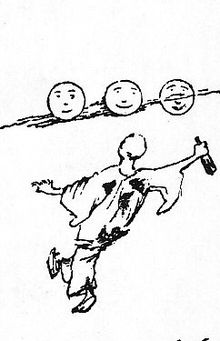
Pierrot lunaire: rondels bergamasques (Moonstruck Pierrot: bergamask rondels) is a cycle of fifty poems published in 1884 by the Belgian poet Albert Giraud (born Emile Albert Kayenbergh), who is usually associated with the Symbolist Movement. The protagonist of the cycle is Pierrot, the comic servant of the Italian Commedia dell'Arte and, later, of Parisian boulevard pantomime.[1] The early 19th-century Romantics, Théophile Gautier most notably, had been drawn to the figure by his Chaplinesque pluckiness and pathos,[2] and by the end of the century, especially in the hands of the Symbolists and Decadents, Pierrot had evolved into an alter-ego of the artist, particularly of the so-called poète maudit.[3] He became the subject of numerous compositions, theatrical, literary, musical, and graphic.
Giraud's collection is remarkable in several respects. It is among the most dense and imaginatively sustained works in the Pierrot canon, eclipsing by the sheer number of its poems Jules Laforgue's celebrated Imitation of Our Lady the Moon (1886).[4] Its poems have been set to music by an unusually high number of composers (see Settings in various media below), including one, Arnold Schoenberg, who derived from it one of the landmark masterpieces of the 20th century. Finally, it is noteworthy for the number of themes of the fin-de-siècle—which is to say, of Symbolism, the Decadence, and early Modernism—that it elaborates within the tight confines of Giraud's verse form:[5]
- the growing materialism and vulgarity of late-19th-century life, and the artist's flight into an interior world;
- the quest of that artist for a purity and untrammeled freedom of the soul, often through a derangement of the senses (advocated most famously by Arthur Rimbaud) via the ecstasy of music or drugs like alcohol;
- the deconstruction of romantic love, inspired in part by a skepticism à la Arthur Schopenhauer and a growing scientific candor (which will result in Krafft-Ebing's Psychopathia Sexualis of 1886) about sex;
- the dogging of young genius by disease, especially consumption, leading to the facile equation (elaborated notoriously in the Degeneration of Max Nordau) of modern art with degeneracy;
- the assumption of a religious burden by the modern artist, and his or her consequent ascension as prophet;
- the transmutation of art into a hermeticism (vide Stéphane Mallarmé, T.S. Eliot, James Joyce, Rainer Maria Rilke) through which it can be enriched with sacred value, spared the gaze of the philistine, and engaged with the dissonant incongruities of modern life: Giraud's poems are non-linear fragments shored against Pierrot's ruins;
- and yet finally: an undermining of the whole enterprise by self-mockery and irony, calling the high creative project (and the motives of the artist indulging in it) in doubt.
